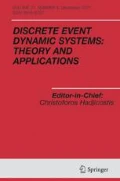Abstract
One of the most serious concerns for wireless sensor networks (WSN) is energy. To obtain long lifetime, one potential method is deploying redundant sensors in the WSN and let each sensor switch its state between ACTIVE and OFF. At the same time, the WSN should meet various requirements of quality of service (QoS). This paper focuses on two important measurements of OoS: sensing coverage and network connectivity. Existing researches have provided many algorithms to schedule the nodes’ states for coverage preserving, including location-free ones. Our work differs from existing location-free algorithms in several key ways: (1). We propose a novel principle on coverage preserving that is suitable for location-free schemes; (2). Following the principle, a distributed, localized and location-free node scheduling algorithm, Stand Guard Algorithm (StanGA), is proposed for treating coverage and connectivity in a unified scheme. Under certain conditions, StanGA can guarantee network connectivity and any degree of sensing coverage. Simulation results show that StanGA is scalable and robust, and also show that StanGA outperforms existing location-free algorithms even when only coverage issue is considered.
Similar content being viewed by others
References
Akyildiz IF, Su W, Sankarasubramaniam Y, Cayirci E (2002) Wireless sensor networks: a survey. Comput Networks 38(4):393–422
Aurenhammer F (1991) Voronoi diagrams—a survey of a fundamental geometric data structure. ACM Comput Surv 23(3):345–405
Bai H, Chen X, Ho YC, Guan X (2005) Percentage coverage configuration in wireless sensor networks. In: Proceeding of International Symposium on Parallel and Distributed Processing and Applications (ISPA 2005), Lecture Notes in Computer Science, vol 3758. pp 780–791
Bai H, Chen X, Guan X (2006) Preserving coverage for wireless sensor networks of nodes with various sensing ranges. Proceeding of 2006 IEEE International Conference on Networking, Sensing and Control (ICNSC 2006), Ft. Lauderdale, FL, pp 54–59 (April 2006)
Carbunar B, Grama A, Vitek J, Carbunar, O (2004) Coverage preserving redundancy elimination in sensor networks. Proceeding of 1st IEEE International Conference on Sensor and Ad Hoc Communications and Networks (SECON 2004), Santa Clara, CA, pp 377–386 (October 2004)
Cardei M, Wu J (2006) Energy-efficient coverage problems in wireless ad hoc sensor networks. Comput Commun 29(4):413–420
Carle J, Gallais A, Simplot-Ryl D (2005) Preserving area coverage in wireless sensor networks by using surface coverage relay dominating sets. Proceeding of 10th IEEE Symposium on Computers and Communications (ISCC 2005), Cartagena, Spain, pp 347–352
Chong CY, Kumar SP (2003) Sensor networks: evolution, opportunities, and challenges. Proc IEEE 91(8):1247–1256
Culler D, Estrin D, Srivastava M (2004) Overview of sensor networks. IEEE Comput, Special Issue in Sensor Networks, vol 37, no. 8. (August 2004)
Gupta P, Kumar PR (1998) Critical power for asymptotic connectivity in wireless networks. Stochastic Analysis, Control, Optimization and Applications, Birkhauser, Boston, pp 547–566
Huang CF, Tseng YC (2005) The coverage problem in a wireless sensor network. Journal of Internet Technology 6(1):1–8
Kumar S, Lai TH, Balogh J (2004) On k-coverage in a mostly sleeping sensor network. Proceedings of ACM Mobicom, Philadelphia, PA, pp 144–158 (September 2004)
Langendoen K, Reijers N (2003) Distributed localization in wireless sensor networks: a quantitative comparison. Comput Networks 43:499–518
Meguerdichian S, Koushanfar F, Potkonjak M, Srivastava M (2001) Coverage problems in wireless ad-hoc sensor networks. IEEE Infocom 3:1380–1387
Mo W, Qiao D, Wang Z (2005) Mostly-sleeping wireless sensor networks: connectivity. k-coverage, and α-lifetime. Proceedings of the 43rd Annual Allerton Conference on Communication, Control, and Computing, September 2005
Okabe A, Boots B, Sugihara K, Chiu SN (1999) Spatial Tessellations: Concepts and Applications of Voronoi Diagrams, Second Edition. Wiley series in probability and statistics. Wiley, New York
Santi P (2005) Topology control in wireless ad hoc and sensor networks. ACM Comput Surv 37(2):164–194
Tian D, Georganas ND (2002) A coverage-preserving node scheduling scheme for large wireless sensor networt. Proceeding of 1st ACM Workshop on Wireless Sensor Networks and Applications (WSNA 02), Atlanta, GA
Tian D, Georganas ND (2004) Location and calculation-free node-scheduling schemes in large wireless sensor networks. Ad Hoc Networks 2:65–85
Wang X, Xing G, Zhang Y, Lu C, Pless R, Gill C (2003) Integrated coverage and connectivity configuration in wireless sensor networks. Proceedings of ACM International Conference on Embedded Networked Sensor Systems (SenSys 2003), Los Angeles, CA, pp 28–39 (November 2003)
Yan T, He T, Stankovic JA (2003) Differentiated surveillance for sensor networks. Proceedings of ACM International Conference on Embedded Networked Sensor Systems (SenSys 2003), Los Angeles, CA, USA, pp 51–62 (November 2003)
Ye F, Zhong G, Lu S, Zhang L (2002a) Energy efficient robust sensing coverage in large sensor networks. Technical Report
Ye F, Zhong G, Lu S, Zhang L (2002b) PEAS: a robust energy conserving protocol for long-lived sensor networks. Proceeding of IEEE Int’l Conf. Network Protocols (ICNP 2002), pp 200–201
Zhang H, Hou JC (2005) Maintaining sensing coverage and connectivity in large sensor networks. Wireless Ad Hoc and Sensor Networks: An International Journal 1(1–2):89–123
Author information
Authors and Affiliations
Corresponding author
Rights and permissions
About this article
Cite this article
Bai, H., Chen, X., Li, B. et al. A Location-free Algorithm of Energy-Efficient Connected Coverage for High Density Wireless Sensor Networks. Discrete Event Dyn Syst 17, 1–21 (2007). https://doi.org/10.1007/s10626-006-0005-9
Received:
Accepted:
Published:
Issue Date:
DOI: https://doi.org/10.1007/s10626-006-0005-9




